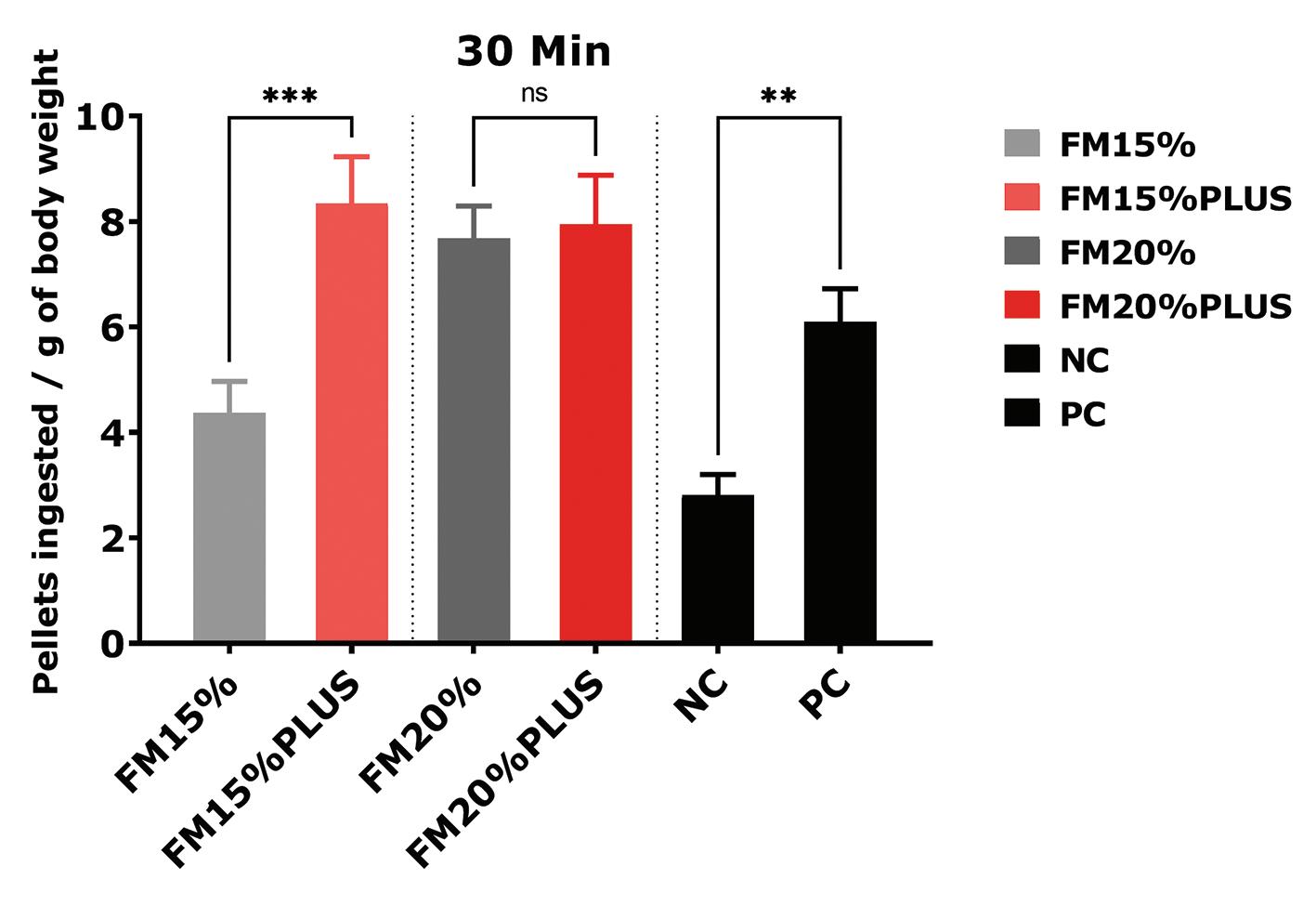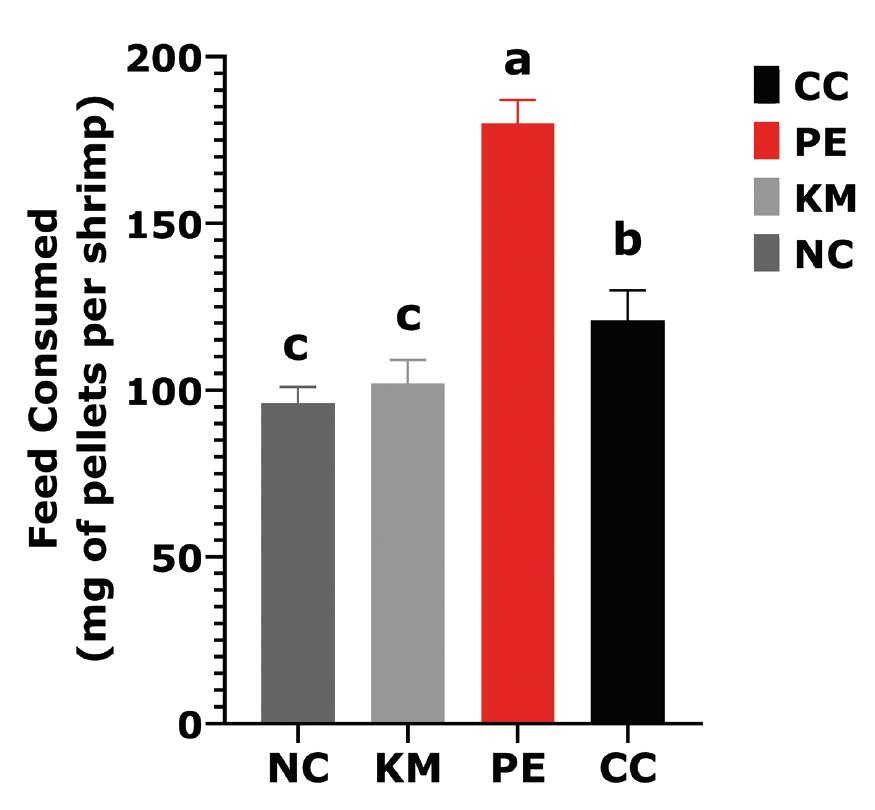
7 minute read
Supporting the replacement of marine animal ingredients Improving palatability and performance in whiteleg shrimp diets
Rui A. Gonçalves, Sofia Morais, Lucta
World aquaculture production of Litopenaeus vannamei was over 4.9 million tons in 2020, representing 53% of crustacean production (FAO 2020), and is expected to continue to increase in coming years. To keep the expected production growth, the shrimp aquaculture industry faces several challenges. The need for consistent and predictable supplies of ingredients is possibly the most critical challenge and its successful accomplishment will be influenced by several factors other than just economics.
Shrimp farming black box
Shrimp are mostly cultivated in environments with low
A
visibility and rich in dissolved chemicals. Furthermore, shrimp are slow and selective feeders, which further increases the risk for high nutrient leaching and feed wastage. In recent years, the utilization of technology in shrimp farming has increased but it’s still complex to get accurate information about fluctuations in production parameters, feed intake, environmental impact, etc.
Shrimp notoriously depends on highly specialized chemosensory systems to identify, locate and ingest food. Therefore, the shrimp industry is aware that formulated diets must be chemically attractive to aid in the rapid localization and ingestion of feed pellets. Palatability enhancement of diets helps to reduce the
B
Figure 1. Palatability trial with individually-housed shrimp (n=15 ± SEM), with pellet intake assessed at 30 minutes (A) and 90 minutes (B) after providing the feed. Experimental diets were formulated to have 8.4-8.7% CF and 35.5-36.0% CP, including increasing levels of fishmeal (15-20%) balanced by decreasing levels of soybean meal (30-23.0%) and varying levels of wheat flour (35.2-37.3%). Poultry byproduct (10.0%) was also included. Asterisks indicate results of t-tests of paired comparisons: ****P<0.0001; ***P<0.001; **P<0.01; ns – non-significant (P>0.05).

leaching of nutrients, not only reducing economic losses but also contributing to a lower waste output and better nutrition of the shrimp.
Traditional use of marine palatants
The complexity of the environment in which shrimp are grown, associated with their natural behavior and highly sensitive chemosensory systems, makes the replacement of marine ingredients a difficult task. Traditionally, the availability and economical soundness of fishmeal and fish oil allowed including these ingredients at levels at which feed intake was optimal. More recently, due to increasing prices and sustainability concerns of fishmeal and fish oil, their utilization as “attractants” was in part replaced by the use of byproducts from fishery and aquaculture processing industries. However, such products often have variable composition and quality due to seasonality and/or little control over processing conditions. In addition, there can be issues with the limited or unpredictable availability of these byproducts.
Therefore, there is a need for products that could guarantee optimization of palatability in a context where the inclusion of marine animal ingredients is reduced.
The present article shows the results of a concentrated product containing selected sources of amino acids and nucleotides, among other flavoring substances, none of animal origin (derived from yeast extracts, vegetable protein hydrolysates or synthetic sources), tested as a palatability enhancer (PE) in white shrimp, Litopenaeus vannamei, diets where a range of marine ingredients was substantially reduced or replaced.
Context: Fishmeal reduction
To test the efficacy of the PE in a fishmeal reduction context, two experimental diets were formulated to have 15% or 20% fishmeal. The diets were tested without (FM15%, FM20%) or with supplementation of 0.2% PE (FM15%PLUS, FM20%PLUS). Two positive and negative controls (PC and NC, IMAQUA proprietary formulation) served as references of high and low palatability to validate the assay. The palatability study, performed at IMAQUA (Belgium), used individually housed shrimp (10-L aquarium, 20 ppt, 27 ± 1°C, 1.5 g, n=15/treatment) in intermold. Each shrimp received 20 pellets of one treatment and the number of uneaten pellets was evaluated 30 and 90 minutes after providing

Figure 2. Palatability study with group-housed shrimp (n=12 ± SEM), with pellet intake assessed 3 hours after providing the feed. Different letters indicate significant differences between treatments (P<0.05, one-way ANOVA followed by LSD posthoc test). The experimental diets contained 7.1% CF and 34.5% CP coming from soybean meal, wheat meal, wheat gluten, and poultry meal as the only animal protein - no fishmeal was included. Standard commercial control (CC) contained a minimum of 8% CF, 40% CP, and 5% squid meal.
the feed. At the end of the trial, shrimp were weighed and the number of pellets ingested per gram of body weight was calculated.
At the 15% FM level, supplementation with PE (FM15%PLUS) significantly and substantially increased the ingested pellets at 30 min (↑ 91%) and at 90 min (↑ 42%), compared to the FM15% control. When the FM20% was supplemented with PE, a numerical (nonsignificant) increase was observed at 30 minutes (↑ 3.5%) and at 90 minutes (↑ 11.5%).
By comparing diets FM20% and FM15%PLUS, it was possible to verify that despite having 5% lower fishmeal, FM15%PLUS treatment ingested 17.7% more feed than FM20%. Therefore, PE supplementation was able to more than compensate the reduction in fishmeal from 20% to 15% (Fig. 1).
Context: Zero fishmeal
A palatability study was performed at Georgia State University, USA (Prof. Charles Derby’s laboratory) testing four diets: 1) a negative control with no fishmeal and without added feeding stimulants (NC), two diets with similar basal composition as the NC but supplemented with 2) 5% krill meal (KM) or 3) 0.3% PE and 4) a standard commercial control (CC).
Juvenile shrimp (average 5.3 g) were group-housed (15 to 30 shrimp per 80-L aquarium, 33-35 ppt, 24-25°C). For each diet, 12 groups of shrimp were tested, giving
Table 1. Growth and feeding performance of shrimp at the end of the 8-week trial (n=3 ± SEM). Means in the same row with different superscripts are significantly different (Fisher’s LSD test; p<0.05).
Control S1 S3 S1+PE0.1 S1+PE0.15 PE0.1 PE0.15
Initial weight (g) 0.91 ± 0.00 0.90 ± 0.00 0.90 ± 0.00 0.90 ± 0.00 0.90 ± 0.00 0.90 ± 0.01 0.89 ± 0.01 Weight gain (%) 581.51 ± 16.99a 615.90 ± 18.60ab 602.95 ± 18.16ab 654.31 ± 5.28b 637.76 ± 20.59ab 603.42 ± 26.20ab 653.28 ± 10.30b
SGR (% day-1)
3.37 ± 0.04a 3.45 ± 0.05ab 3.42 ± 0.04ab 3.54 ± 0.01b 3.50 ± 0.05ab 3.42 ± 0.07ab 3.54 ± 0.02b
Feed intake (g/shrimp)
9.52 ± 0.08a 10.21 ± 0.19b 9.84 ± 0.02ab 10.04 ± 0.08ab 10.04 ± 0.24ab 10.25 ± 0.32b 10.36 ± 0.12b
FCR
1.90 ± 0.09 1.87 ± 0.05 1.89 ± 0.08 1.75 ± 0.01 1.75 ± 0.03 1.99 ± 0.15 1.87 ± 0.07
Survival (%)
92.22 ± 4.44 96.67 ± 3.33 94.44 ± 2.94 93.33 ± 1.92 98.89 ± 1.11 92.22 ± 4.01 92.22 ± 2.22
them 13 g of pellets and allowing 3 hours to feed, after which the remaining pellets were collected, dried, and weighed. Palatability was quantified as milligrams of pellets eaten per shrimp, corrected for the change in dry mass of pellets in water.
Results indicate that during the three-hour palatability study, 0.3% PE was significantly more effective (↑ 75%) than 5% krill meal as a feeding stimulant and the PE diet was 88% more consumed than the NC. Furthermore, zero fishmeal PE-supplemented pellets were significantly (↑ 49%) more palatable than the commercial (CC) diet (Fig. 2).
Context: Squid paste replacement
A higher feed palatability does not necessarily mean an improved growth performance. Therefore, to test the performance-enhancing efficacy of the PE, an 8-week growth study was conducted at the Laboratory of Fish Nutrition, Ningbo University, China. Shrimp paste is commonly used in China as a feeding stimulant and the study evaluated PE as an alternative to partially or completely replace squid paste in shrimp diets.
Whiteleg shrimp (0.9 g; n=30, triplicate) were grown in an indoor flow-through system (300 L tanks; 27-35°C; 24.7-29.1 ppt). Shrimp were hand-fed three times daily. Experimental diets with 43% CP and 8% CL were formulated containing 20% fishmeal, 67% vegetable meal and 5% poultry meal (CTR), and were further supplemented with a squid paste (Ningbo Tech-Bank Aqua Feed Co., Ltd.) at either 1% (S1) or 3% (S3), a combination of 1% squid paste and the PE at 0.1% (S1+PE0.1) or 0.15% (S1+PE0.15), or the PE alone at 0.1% (PE0.1) or 0.15% (PE0.15). At the end of the trial, intestine and hepatopancreas samples were collected for enzyme (lipase and protease) activity and histology analysis. Supplementation of 1% squid paste with 0.1% PE (S1+PE0.1) or total replacement of squid paste with 0.15% PE (PE0.15) significantly improved growth over the control. In addition, the highest feed intake (significantly different from the control) was obtained with PE alone (at 0.1% or 0.15%) or with S1 (Table 1). Functional effects were also observed (Zhu et al., 2019), with an enhancement of hepatopancreatic protease activity (U/ mg protein) in S1+FPE0.15, compared to the control or S1. Furthermore, intestinal fold heights were significantly increased in PE0.1 or PE0.15, compared to S1.
Conclusions
The tested palatability enhancer is highly effective as a concentrated (high intensity) chemostimulant that increases the ingestion of feed pellets where different marine ingredients (fishmeal, krill meal or squid paste) have been reduced or replaced. Furthermore, the enhanced palatability is reflected in higher growth performance and improved functionality (protease activity and intestinal histomorphology) of shrimp.
References available on request.
More information: Rui A. Gonçalves
Aquaculture Innovation Manager and Business Development Lucta E: ruialexandre.goncalves@lucta.com
Sofia Morais
Innovation Aqua Team Leader Lucta E: sofia.morais@lucta.com








